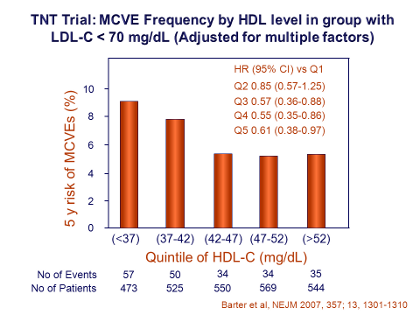Barter - Figure 3 - TNT by HDL levels Text
The Treating to New Targets (TNT) trial[13] randomized 10,001 patients to 10 or 80 mg/day of high-potency atorvastatin and followed them for an average of 4.9 years. The results were that patients on the higher dose achieved a mean LDL cholesterol level of 77 mg/dL, which was associated with a 22% relative risk reduction (p<0.001) over the risk reduction achieved by the patients on the lower dose (who only achieved a mean 101 mg/dL LDL cholesterol level). Because the greater reduction in LDL cholesterol to historically low levels produced a greater risk reduction, it was suggested (quite reasonably) that perhaps if the LDL cholesterol is low enough, the HDL cholesterol level does not matter.
This would be a difficult hypothesis to test prospectively, but in 2007 the results of a post hoc analysis of the TNT data were published.[14] This analysis looked at the 2661 participants for whom HDL cholesterol levels were measured and who achieved a serum LDL cholesterol level <70 mg/dL on treatment. These results were then divided into quintiles, depending on HDL level, and what can be seen in the Figure is that even though all these patients had achieved an historically low LDL cholesterol level <70 mg/dL, their ultimate CHD risk was still a function of their HDL cholesterol level, with their hazard ratio for having a major cardiovascular event (MCVE) decreasing from 0.85 down to 0.61. In other words, having a low HDL level, <40 mg/dL, was associated with a highly significant increase (ie, a much smaller decrease) in risk of experiencing a MCVE.
It could be objected that surely these people with LDL levels <70 mg/dL but still at greater risk than others with LDL <70 mg/dL must have been obese, or had diabetes, or been smokers, or must have been men versus women. However, as shown in the Figure, these data were adjusted for all of those factors. As a result, what this analysis says is that having a low serum HDL cholesterol level identifies risk, even in people aggressively and successfully treated with statins to reduce LDL levels. This does not diminish the importance of lowering LDL cholesterol levels; this simply says that statin treatment has not fully corrected the risk associated with dyslipidemia.
J Clin Lipidol. 2011; 5(6).References
[13]LaRosa JC, Grundy SM, Waters DD, et al. Intensive Lipid Lowering with Atorvastatin in Patients with Stable Coronary Disease. N Engl J Med 2005;352.
[14]Barter P, Gotto AM, LaRosa JC, et al. HDL Cholesterol, Very Low Levels of LDL Cholesterol, and Cardiovascular Events. N Engl J Med 2007; 357:1301-1310
